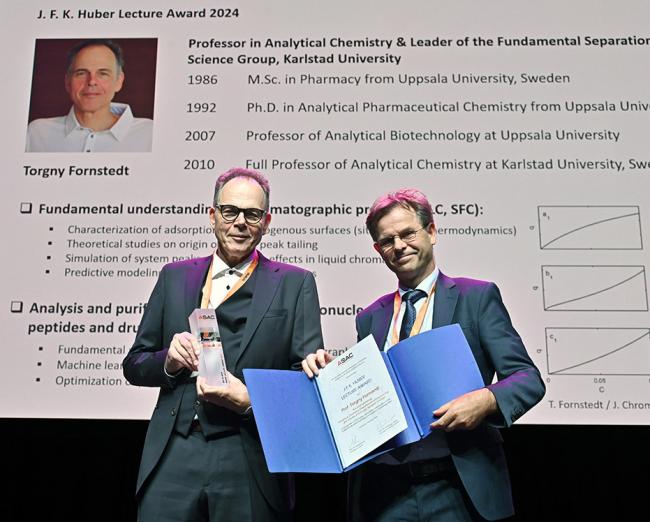Honoured for research in fundamental separation science
2024-11-08Professor of Analytical Chemistry Torgny Fornstedt received the J. F. K. Huber Lecture Award at the International Symposium on Chromatography (ISC 2024) in Liverpool in October. The award was given for ‘highly recognised contributions to the fundamental understanding of adsorption chromatography’.
‘This distinction means a great deal to me, as J. F. K. Huber was involved in launching chromatography research in analytical chemistry at Uppsala University, my alma mater’, said Fornstedt.
J. F. K. Huber Lecture Award
The J. F. K. Huber Lecture Award is given by the Austrian Society of Analytical Chemistry (ASAC). It was created in 2014 to honour researchers who have made major contributions to the development of the HPLC method in terms of both theory and practice. Professor Joseph Franz Karl Huber was one of the pioneers of chromatography, which is one of the most important separation methods for pharmaceuticals. J. F. K. Huber collaborated with, among others, Professor Göran Schill at Uppsala University to conduct the fundamental separation research for which he received an honorary doctorate there in 1983. The research in Uppsala was done in close collaboration with the former Astra Hässle, now AstraZeneca.
Professor Fornstedt began his career in the separation research milieu at Uppsala University. He relocated to Karlstad University in 2010, bringing his fundamental research into chromatographic separation methods to that seat of learning.
‘The move to Karlstad University was made based on the opportunity to seek funding from the Knowledge Foundation at the new university. This enabled me, for a period of time, to form a group of researchers with funding from both the Swedish Research Council and the Knowledge Foundation, so that our academic collaboration with pharmaceutical companies could evolve’, said Fornstedt.
In his nearly 15 years at Karlstad University, Professor Fornstedt has, along with his colleagues Jörgen Samuelsson, Patrik Forssén, and Martin Enmark, received a total of SEK 43 million (with the company's co-financing, 73 million) in research funding for some dozen projects carried out in collaboration with AstraZeneca and other companies in the bioscience sector. The funding for research at Karlstad University has resulted in over 60 articles in prestigious publications, many produced in collaboration with the pharmaceutical industry.
‘This research has been conducted completely in the spirit of J. F. K. Huber, with theory and practice being combined in order to understand how pharmaceutical molecules interact with surfaces and with one another during separation’, said Professor Fornstedt. ‘We are now using the knowledge gained to predict optimal operational conditions for separating the drugs of tomorrow. After me, Senior Lecturer Jörgen Samuelsson will continue to conduct fundamental separation research at Karlstad University’.
J. F. K. Huber’s vision led to the development of UHPLC
Liquid chromatography is a method for separating the chemical substances found in a sample. A steel tube is filled with small porous particles whose surfaces have been modified using hydrocarbon chains to create a lipid surface. A liquid is pumped through the tube, and a sample mixture is injected into the liquid stream. Separation occurs in that the substances in the mixture migrate through the tube at different speeds, as they are absorbed to the lipid surfaces of the particles to varying degrees. Each substance that is separated emerges from the tube at a different time and is recorded as a peak, thereby enabling precise content determination.
Only large particles were used in the infancy of chromatography, and Martin and Synge won the Nobel Prize in Chemistry in 1952 for chromatography systems handling such particles. The separating capacity of these systems was rather modest, and dramatic improvements were needed if the method was to achieve a breakthrough in the pharmaceutical industry. J. F. K. Huber perceived the benefits of reducing the particle sizes, and understood that the liquid would then have to be pumped at high pressure. Ultra-high-pressure liquid chromatography (UHPLC) has now been developed, in which particles measuring less than 2 µm in diameter are used, while the liquid is forced through the tube at a pressure of over 1000 bar. This approach has cut the separation time to one-quarter of that achieved in the HPLC of the past using traditional 5-µm particles.




